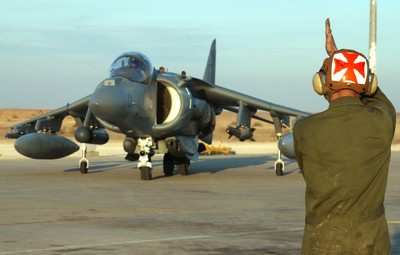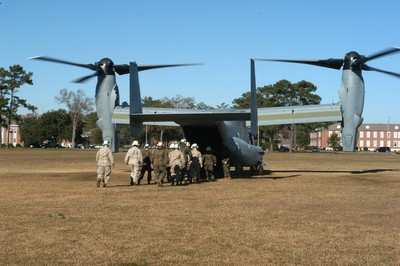 The Marine Corps
aviation component is transforming along with the total force while
keeping its focus on its most important priority, supporting the
Marines fighting on the ground, according to a senior Marine
aviation officer, last week.
The Marine Corps
aviation component is transforming along with the total force while
keeping its focus on its most important priority, supporting the
Marines fighting on the ground, according to a senior Marine
aviation officer, last week.
While aviation is not usually associated with the Marine Corps,
it is actually an essential element of the force, because it
enables the Marines to respond quickly to requirements around the
globe with a lighter, more versatile force, Marine Col. Robert
Walsh, deputy assistant commandant for aviation, said in a Pentagon
Channel interview last week. Aviation makes up about one-third of
the total Marine Corps, with about 1,200 aircraft, Walsh said.
The Marines often respond more quickly than the Army, because
they don’t bring the heavy capabilities the Army does, Walsh
explained. “To be able to support that Marine on the ground,
we bring a lot more of our fire from the air than the Army
does,” he said. “Because we’re a lighter,
quicker-to-the-fight force, we rely much more on aviation as an
integral part of this team, this Navy-Marine air-ground
team.”
As the battlefield has shifted in the 21st century to more
irregular warfare, Marine aviation also has shifted its role, Walsh
said. To better support the Marines fighting on the ground in urban
environments, aircraft have been doing more intelligence,
surveillance and reconnaissance work to give the ground forces more
awareness of the situation, he said.
While this transformation is important, Walsh noted, the
commandant of the Marine Corps has given clear guidance that the
entire force stay versed in conventional capabilities, to be
prepared for anything that could happen in the future. For Marine
aviation, this means maintaining the ability to integrate ground
and air forces to best accomplish the mission, Walsh said.

“We’ve got to continue to look at where we want to
be in the future and what the Marine Corps wants to do,” he
said. “That’s where we go back to our roots --
conventional capabilities – so we don’t get so focused
in the one area that we’re not able to shift gears quickly,
because the enemy’s not going to give us that notice to be
able to spool up quickly and shift gears. So we can be that force
that’s most ready when the nation’s least
ready.”
Sustaining the current force is the first priority of Marine
aviation, Walsh said. This includes ensuring that aircraft sent to
the theaters of operation are in good condition and ready for use,
he said. The Marine Corps is also rotating its aircraft more often
and putting them through a “reset” program in the U.S.
before deploying them again, he explained.

The second priority of Marine aviation is modernizing the force,
Walsh said. The modernization is happening service-wide, but in the
aviation component it means replacing older, legacy aircraft with
new technology, he said. Specifically, the KC-130J is being
integrated to the force as an air and ground refueler, and the
MV-22 Osprey is replacing the CH-46 Sea Knight.
Both of these aircraft bring new capabilities to the force that
will change the way it operates on the battlefield, he said. The
Osprey will be able to go twice as fast, have six times the range,
seven times the ballistic tolerance capability, one-fourth the
infared signature, and one-sixth of the acoustic signature of the
CH-46, he noted, and will be able to go to altitudes above 10,000
feet. The KC-130J brings air refueling capabilities to the aviation
force, he added.
Another aircraft that will modernize the force is the Joint
Strike Fighter, Walsh said. The Joint Strike Fighter is being
purchased by the Navy, Air Force, Marine Corps and about nine
partner nations, and in the Marine Corps will replace two aircraft:
the AV8-B Harrier and the F-18 Hornet. The fighter is being
developed as a stealth aircraft with precision fire capabilities,
but it will also bring other assets to the Marines, he said.

“We see using the Joint Strike Fighter as an integrator
– really a battlefield integrator or an enabler between the
air and the ground,” Walsh said. “It’s going to
have intelligence, surveillance, and reconnaissance command and
control capabilities, along with a lot of network sharing.
It’s going to have capabilities of ensuring our Marine on the
ground – building their situational awareness as much as we
can.”
As Marine aviation, and the Marine Corps at large, transforms to
meet the requirements of the 21st century, the force’s
leaders are focusing on strengthening the partnership with the
Navy, Walsh said. The Marines’ current role in Iraq can draw
attention away from the service’s affiliation with the Navy,
but that affiliation is important because it often ensures access
to remote parts of the world, he explained.
Marine aviation is in an exciting time right now, when new
technologies are rapidly becoming available and bringing new
capabilities to the force, Walsh said. Even as the force
transforms, it is staying true to its roots of supporting Marines
fighting on the ground, he said.

“The technology’s going to enable us to do many more
things, and today’s young Marines understand technology
better than anybody, and they’re going to have the capability
to experience that,” he said. [ANN Salutes Sgt. Sara Wood,
USA American Forces Press Service]
 ANN's Daily Aero-Linx (04.13.24)
ANN's Daily Aero-Linx (04.13.24) ANN's Daily Aero-Term (04.13.24): Beyond Visual Line Of Sight (BVLOS)
ANN's Daily Aero-Term (04.13.24): Beyond Visual Line Of Sight (BVLOS) Airborne 04.09.24: SnF24!, Piper-DeltaHawk!, Fisher Update, Junkers
Airborne 04.09.24: SnF24!, Piper-DeltaHawk!, Fisher Update, Junkers Aero-News: Quote of the Day (04.14.24)
Aero-News: Quote of the Day (04.14.24) ANN's Daily Aero-Term (04.14.24): Maximum Authorized Altitude
ANN's Daily Aero-Term (04.14.24): Maximum Authorized Altitude







